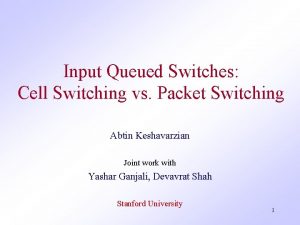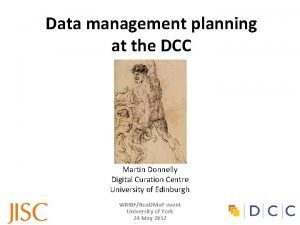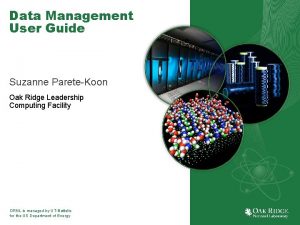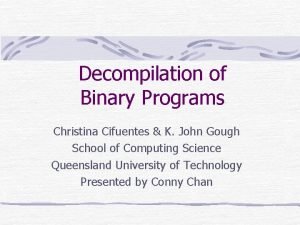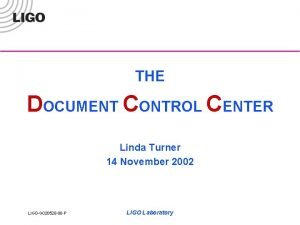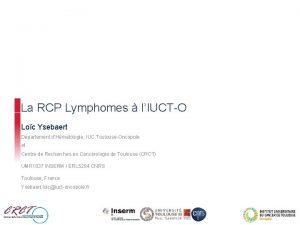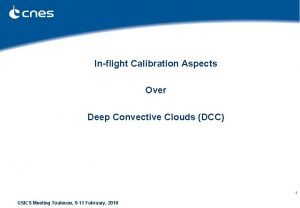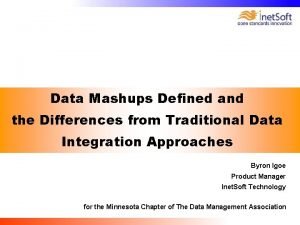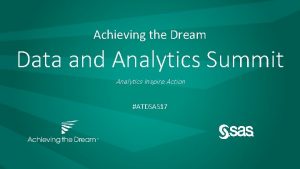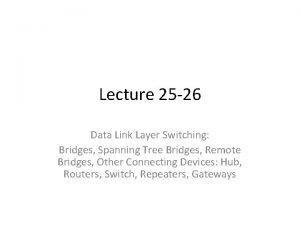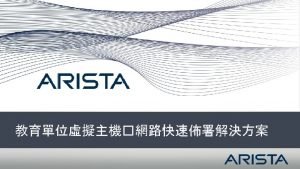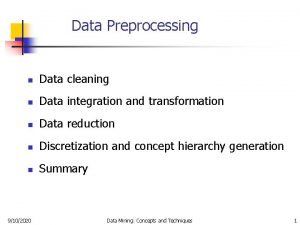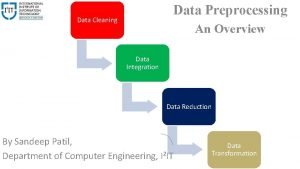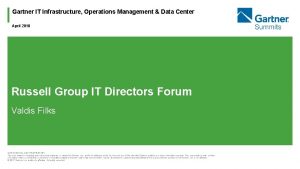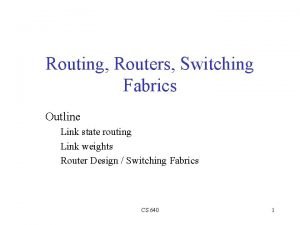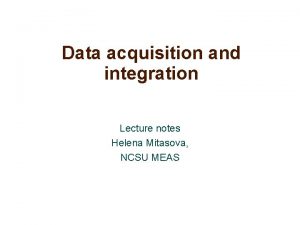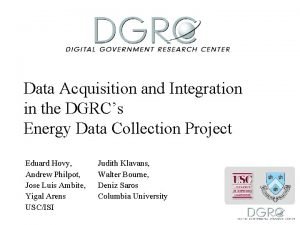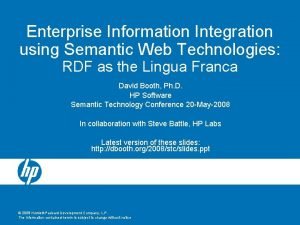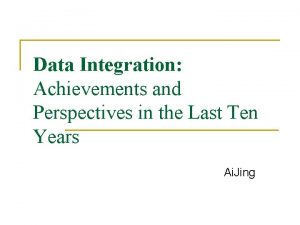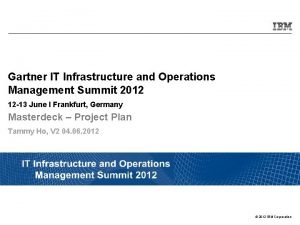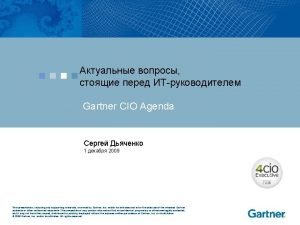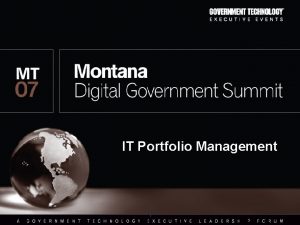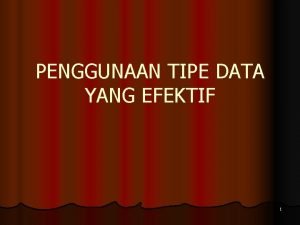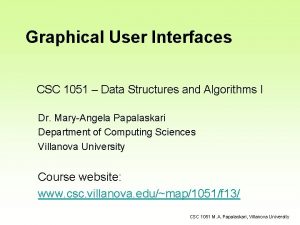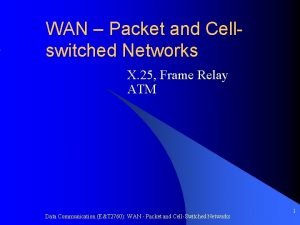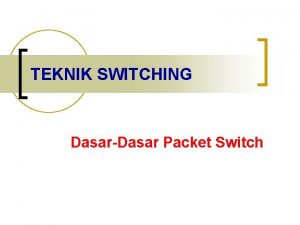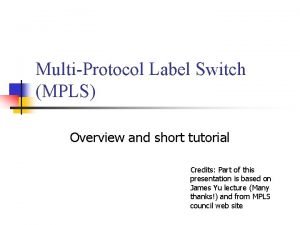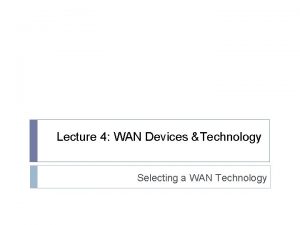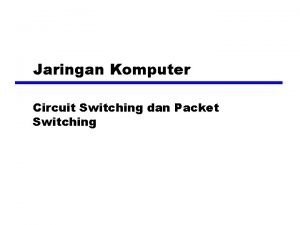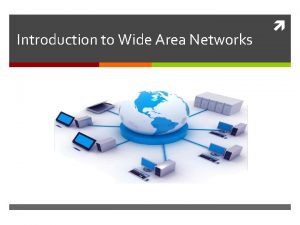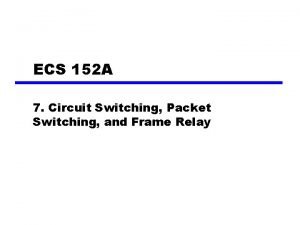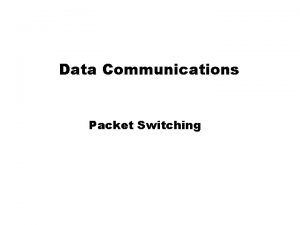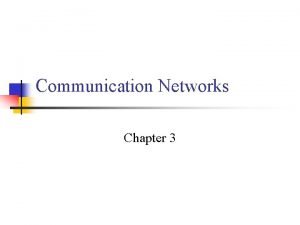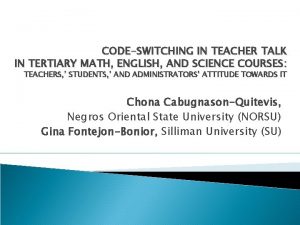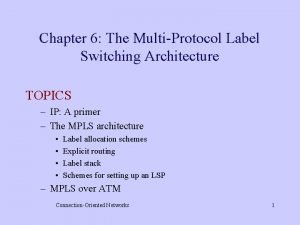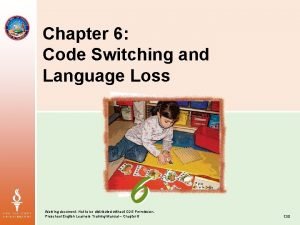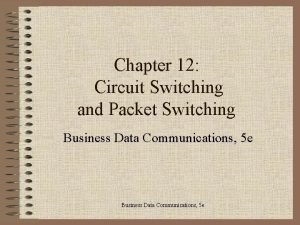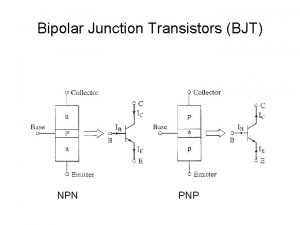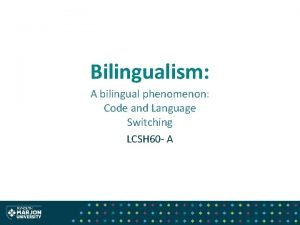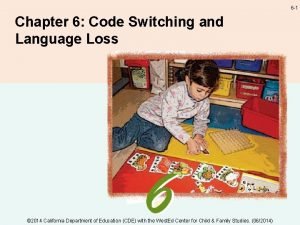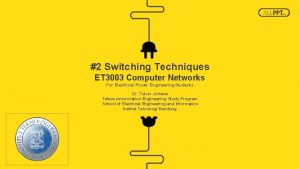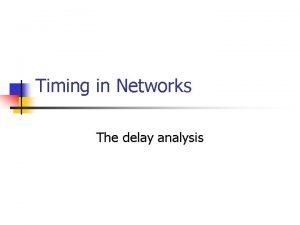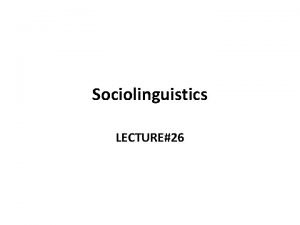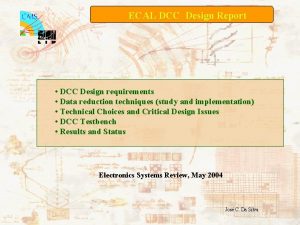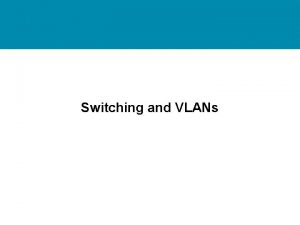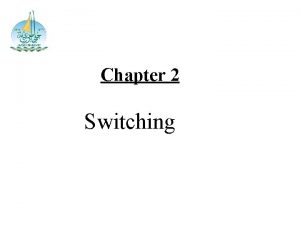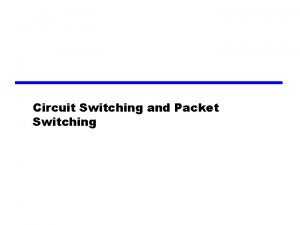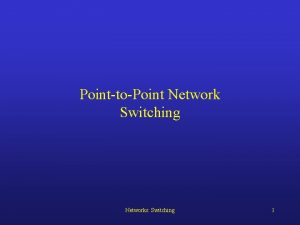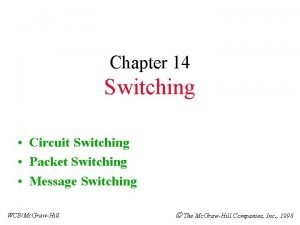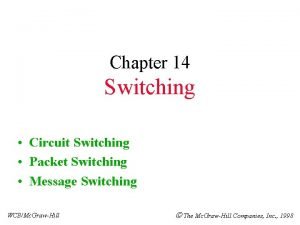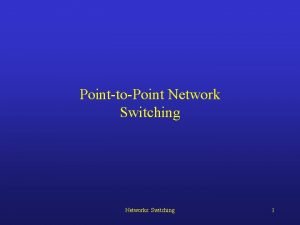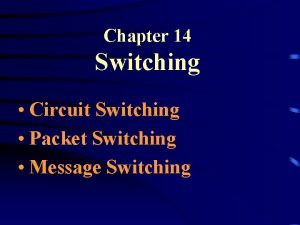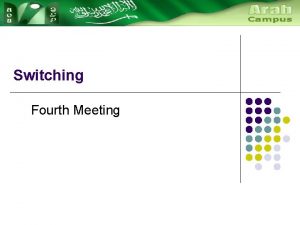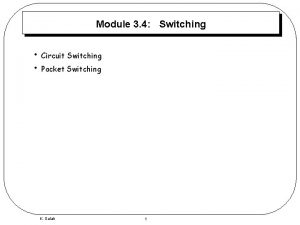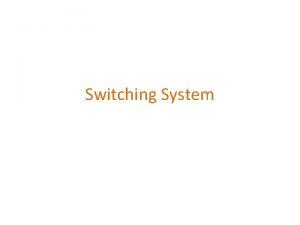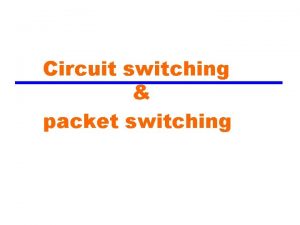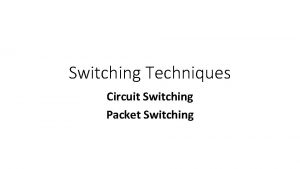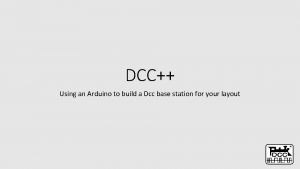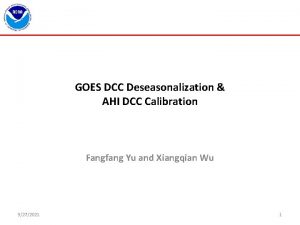DCC Switching Industry Summit Data and User Integration






































































- Slides: 70

DCC Switching Industry Summit Data and User Integration Testing (UIT) 14 October 2020 DCC Public

Agenda Session 1 – Programme Update & Data Matching 10. 00 – 10. 05 Programme Director Welcome Richard Hilton (Chair) 10. 05 – 10. 20 Programme Update Richard Hilton, Keith Howie 10. 20 – 10. 25 Data Sub-Programme Update Laura Kanabe 10. 25 – 10. 35 Data Quality Approach Richard Clarke 10. 35 – 11. 10 Data Matching and Demonstration Lokesh Shrivastav 11. 10 – 11. 20 Data Q&A Lokesh Shrivastav, Richard Clarke Session 2 – The Path to User Integration Testing 11. 30 – 12. 10 The Path to User Integration Testing Mark Deacon 12. 10 – 12. 20 UIT Q&A Mark Deacon, Nicola Farley Session 3 – Looking to the Future 12. 30 – 12. 50 Roadmap Update Paul Morcom, Chris Spence 12. 50 – 13. 10 Consumer Perspectives Julie Cordina, Danielle Hill 13. 10 – 13. 20 Final Q&A Richard Hilton, Keith Howie, David Purdy 13. 20 - 13. 30 Survey and Close Keith Foster, Richard Hilton DCC Public February 2021 | 2

Welcome Richard Hilton, Switching Programme Director, DCC Keith Howie, Deputy Programme Director, DCC Public

Programme update • Significant management focus for the period has been applied to supporting the Switching Programme re-plan activities. This is as a result of an Ofgem and industry request to push back the Programme Go-Live date due to the circumstances caused by the Covid-19 pandemic. • Industry consultation on the Programme re-plan will complete in October 2020 and the plan is expected to be re-baselined at the Delivery Group on 27 October 2020. • Good progress continues to be seen in Functional Systems Integration Testing (SIT). Test Window 1 completed on time and Test Windows 2 and 3, running in parallel, remain on track to complete as per the agreed plan. • Non-Functional SIT was paused in July 2020 due to a security incident. Following a detailed review and DCC Chief Information Security Officer (CISO) risk assessment the criteria and steps to resume testing were agreed. Testing resumed on 05 October 2020. The hiatus from testing has had no impact to the Programme critical path. • Functional Data Migration Testing (DMT) completed ahead of schedule on 03 September 2020. Formal approval of this milestone will be sought at the Data Working Group in October 2020. • The DCC-commissioned independent testing health check, led by Expleo, concluded in August 2020. The health check identified several key recommendations – good progress is being made on implementing these ahead of future test phases. • Good progress has been made to incorporate Switching into the DCC Technical Operations Centre (TOC). A number of workshops were held between Landmark, Capgemini and the DCC TOC team in September 2020. DCC Public February 2021 | 4

Data Sub-Programme Update Laura Kanabe DSP and Data Sub-Programme Manager, DCC Public

Sub-Programme overview The first exit of a major Switching test phase has been achieved: Functional DMT • 1455 tests were completed • Functional DMT execution was completed slightly ahead of schedule • Usability of data is included in the Functional SIT regression testing Report from final day DMT test runs Next key activities… Test phases Non-Functional DMT Live Rehearsal Milestone L 1 DA 550: Decision on Central and Source Retail Energy Location (REL) Data Cleanse approach and timescales DCC Public February 2021 | 6

Plans on a Page for the next test phases Non-Functional DMT Programme Milestones • L 2 DA 270 = DMT (Non-functional) start (07 December 2020) • L 2 DA 280 = DMT (Non-functional) complete (09 April 2021) Live Proving Programme Milestones • L 2 TR 020 = DMT (Live Rehearsal) start (17 May 2021) • L 2 TR 030 = DMT (Live Rehearsal) complete (29 October 2021) DCC Public February 2021 | 7

Decision on Central and Source REL Data Cleanse Approach and Timescales • DCC is working together with Ofgem to complete the DA 550 milestone: Decision on Central and Source REL Data Cleanse Approach. • The DA 550 artefact, a proposal on the data cleanse approach, will address the split between what address matching can be done centrally and what will be sent to the source data providers for cleansing. • The proposal will be based on the outcomes of the centralised address matching pilot that Landmark has executed. • It will present a plan for the estimated volumes of data that source data providers will receive and the timescales for cleansing and include: o The plan; o The processes that will need to be followed; o A description of assurance to be applied; o A description of the approach to data security; and o Recommendations on the execution of the process. DCC Public February 2021 | 8

Data Quality Approach Richard Clarke DCC Public

Summary The Switching Programme is tasked with matching over 55 m source Meter Point Location addresses against Ordnance Survey Address. Base Premium (ABP) with the Address Data Quality maintained through: • Matching source MPL addresses to a database conforming to BS 7666; • Matching only where near certainty in the match is achieved (Gold Standard); • Integrity of the address match is paramount, any ambiguity means a match isn’t assigned; • Regular audit of results to verify the process is delivering on integrity of addresses; • Partnership with Landmark – an experienced and expert data company at the forefront of data supply to the UK’s property market; • Using an automated toolset including complex algorithms and interactive address matching within a highly skilled team; and • Using other data sources – e. g. Smart Meter data. DCC Public February 2021 | 10

Data Flow, Matching and Audit RMP and Registration Data Files at Migration Source MPL Data Secure Transfer Landmark Algorithm Matched Unmatched Realignment and Algorithm Data Source Providers Unmatched Interactive Address Matching Matched 'Banked' and Audited Transition / Migration to Central Switching Service REL Addresses Assigned to MPx. Ns 'Go Live' Reconciliation Matched Unmatched Residue Other Data Source Request for Local Cleansing DCC Public February 2021 | 11

The ‘Gold Standard’ is defined as an address which meets the following conditions: • Confidence Score => 90 when matching against a BS 7666 address database AND it is the ONLY candidate address (stands alone) OR • Confidence Score => 90 and has been manually assured to be the correct property where one or more candidate addresses exist OR • Where manual address matching has determined an appropriate match against the BS 7666 address database. The ‘Confidence Threshold’ - score set at 90 and based upon: • Landmark’s experience to date of address matching across multiple clients; • Landmark and DCC’s assurance of a random sample of unmatched addresses below 90 to ensure they don’t represent a correctly ‘matched’ address; • Auditing a sample of matched addresses to ensure they do not contain ‘false positives’ i. e. ensure the integrity of the match is maintained; • Robust and tested weighting for all different address elements by Landmark in order to define the most appropriate confidence score profile by address fields; and • Subject to additional DCC governance and analysis. DCC Public February 2021 | 12

Additional Quality Assurance The address matching process incorporates: • Updates to ‘banked’ addresses for changes to addresses received from Data Source Provider in later data cuts; • Updates to ‘banked’ addresses for periodic changes to postcodes; • The address match logic is carried out using multiple passes of an algorithm based on different combinations of address fields; • Regular DCC assurance of interactively matched addresses to ensure ‘false positives’ are not being accepted; and • Ability to securely send matched data back to data source providers to review and confirm REL addresses. DCC Public February 2021 | 13

Data Matching and Demonstration Lokesh Shrivastav Landmark DCC Public

Contents • Address Matching: o • • • Objectives, standards and variations. Address data assurance: o How the results were achieved; and o Process overview. Interactive address matching o Process overview; and o Demonstration. Post address matching process. DCC Public February 2021 | 15

Recap on address standards There are no “official” address standards in the UK: • No “official” address in England, Scotland or Wales; and • No “official” standards for structuring an address. The following are the most used country-wide address files 1. Royal Mail Postcode Address File. 2. Ordnance Survey Address. Base. 3. HM Land Registry Register of Land Property. 4. Valuation Office and Scottish and Northern Irish equivalents. 5. The National Land Property Gazetteer which is created from 440 Local Land property Gazetteers. Only the first two of these are in the public domain for commercial use. DCC Public February 2021 | 16

The address standard used by Ordnance Survey DCC Public February 2021 | 17

A single address can have many variants TYPE ADDRESS Historic LAND SOUTHWEST OF LITTLE WEYBOURNE, STOKE ROAD, COBHAM, KT 11 3 BD Provisional HALF ACRE, STOKE ROAD, COBHAM, KT 11 3 BD Approved 34 STOKE ROAD, COBHAM, KT 11 3 BD Alternative OAK COTTAGE, STOKE ROAD, COBHAM, KT 11 3 BD Delivery 34 STOKE ROAD, COBHAM, KT 11 3 BD Delivery Welsh None Same BLPU/UPRN references all variants DCC Public February 2021 | 18

How the results are achieved STAGE 1 STAGE 2 STAGE 3 STAGE 4 DCC Public February 2021 | 19

Known issues with input address data Trends Impact Mitigation level Advice Spelling mistakes Low/Med Fuzzy logic matching Standardised capture Missing address information High Interactive address matching Standardised capture Med/High Complex rule base Standardised capture Incorrect address information Information supplied in wrong fields Ambiguous information DCC Public February 2021 | 20

The impact of spelling mistakes on address matching WESTBERRY 5 4 3 WESTBER_Y 4 5 BWESTURY 3 WSTBRY BWESTURY WSTBRY BESTBERY WESTBURY 2 3 4 3 2 3 3 3 5 1 4 2 2 2 1 5 2 3 BESTBERY 3 3 4 2 5 3 WESTBURY 4 3 2 3 3 5 DCC Public February 2021 | 21

An example of complete auto-matching INPUTS PROCESSE S OUTPUTS – MATCH CANDIDATES Match score thresholds Pre processing MPL Data Multiple candidates - Unmatched 90 - 100 Very High Element parsing OS Address. Base Premium Degree of certainty Element scoring 80 – 89. 99 High 50 – 79. 99 Medium 20 – 49. 99 Low 0 – 19. 99 Very Low Unmatched Normalise match scores DCC Public February 2021 | 22

Address Matching – Unmatched records & interactive address matching

The scope of the address matching pilot DCC Public February 2021 | 24

The correction of mis-aligned source data Initial Review of Unmatched Source Data: • Numerous alignment issues; and • Frequent duplication of information across multiple fields. DCC Public February 2021 | 25

How mis-alignments are corrected Address Element Type Sub Bldng Name Or No. Building Name Expected values 1 A Building 1 B Building Number 1 C Thoroughfare 2 A dependant. Thoroughfare Street double. Dependant. Locality Dependant Locality 3 A Town Post Town County Postcode 2 B 3 B 3 C County 4 Postcode 5 DCC Public February 2021 | 26

How mis-alignments are corrected Expected values Simple misalignment 1 A 1 A 1 B 1 B Building Number 1 C 2 A Thoroughfare 2 A 2 B 2 B 3 A Address Element Type Sub Bldng Name Or No. Building Name dependant. Thoroughfare Building Street double. Dependant. Locality Dependant Locality 3 A Town Post Town County Postcode 3 B 3 C 3 C 4 County 4 Postcode 5 DCC Public 5 February 2021 | 27

How mis-alignments are corrected Expected values Simple misalignment Complex misalignment 1 A 1 A 1 B 1 B 1 B 3 A Building Number 1 C 2 A 3 A Thoroughfare 2 A 2 B 2 2 B 3 A Address Element Type Sub Bldng Name Or No. Building Name dependant. Thoroughfare Building Street double. Dependant. Locality Dependant Locality 3 A Town Post Town County Postcode 3 3 B 3 C 3 C 4 County 4 Postcode 5 DCC Public 5 5 February 2021 | 28

Interactive address matching tools Core Tool • i. Match Manager V 2, a text and map based address matcher: o o Presents multiple Address. Base Premium candidates to select from; and Presents a location on a map to aid selection Reference Tools • Singlepoint, an Address. Base Premium lookup which presents all attributes of Address. Base Premium. • Google which supports the searching of additional resources. DCC Public February 2021 | 29

i. Match, the interactive address matching process Login Allocate record in i. Match Address match Assign Confidence Score System – Submit to database (banked REL) Feedback/ amends QA/QC System – allocate UPRN (after auto match and cleanse) DCC Public February 2021 | 30

Demonstration of i. Match DCC Public February 2021 | 31

Data Q&A Richard Clarke, Lokesh Shrivastav DCC Public

BREAK DCC Public February 2021 | 33

Path to UIT Mark Deacon UIT Team Lead, DCC Public

Contents • High level scope of UEPT & E 2 E • Licensed Parties – what you’ll be doing • UIT documentation to help with your preparation • Documentation governance stages • Support • Q&A DCC Public February 2021 | 35

User Integration Testing comprises two key stages UEPT (User Entry Process Testing) • User Entry Process Testing (UEPT) allows each Licensed Party and its Switching Programme registered Agents to demonstrate their eligibility to connect to the Central Switching Service (CSS) and test their compliance against an agreed and defined series of Test Scenarios. • All Licensed Parties are required to undertake UEPT, it is currently envisaged that ~140 parties will be progressed through UEPT. • Those Licensed Parties with >250, 000 Registerable Meter Points (RMPs) who successfully complete UEPT will be mandated to move into E 2 E. • UEPT is split into 4 Tranches where each Licensed Party will be allocated to a Tranche by the Licensed Party Coordinator (LPC), Tranche 1 will be allocated to those Parties who will be mandated for E 2 E. The Counter Party Simulator will be used to progress switches and verify the required responses for both gaining and losing roles. E 2 E (End to End) • E 2 E applies to Licensed Parties with >250, 000 RMPs who have successfully completed UEPT but E 2 E is also available to Volunteer Licensed Parties who may wish to conduct testing to verify their own systems and processes against the CSS. • E 2 E allows Licensed Parties to demonstrate they can utilise the E 2 E service interactions through their respective business systems via a set of defined test scenarios to demonstrate they can operate within the market. • In the E 2 E phase Licensed Parties will be paired to progress switches and verify the required responses for both gaining and losing roles. • Licensed Parties can, if they wish, conduct their own testing in the E 2 E phase to verify aspects of their design outside the defined E 2 E test scenarios. DCC Public February 2021 | 36

High level scope of UEPT In line with the issue of the Ofgem guidance note on Scope of Licensed Party Testing the following schematic diagrams represent the 4 key UEPT testing scenarios that Licensed Parties will need to consider to complete their respective testing. Each of these is included in the UEPT Test Plan document (NCT-0038): Centrally hosted Adaptor and Third-Party IT Service Provider Third-Party IT Software Provider Supplier connects directly to CSS not using Adaptor or 3 rd Party Supplier / Software provider Suppliers that use their own CSS Interface no 3 rd Parties DCC Public February 2021 | 37

Path to UIT – Licensed Parties, what you’ll be doing • All the key requirements covering the scope of UIT can be found in the 25 th of September communication from Ofgem • There are several document attachments that provide Licensed Parties with key plan and milestone information that underpins the scope of the Switching Programme stages including UEPT and E 2 E: • Full Plan Review Summary Document As well as covering the scope approach and governance of the overall Programme this document also provides the ‘Road to UEPT’ and ‘Road to E 2 E’ which sets out the logical steps aligned to the key milestones in the MAD log that all parties need to follow and deliver against • Ofgem PMO Planning Guidelines Outlines how the plan is structured and the how to use/apply the key documents • POAP The overall Faster Switching schematic plan on a page • MAD Log Provides the full list of level 1, 2 & 3 milestones that underpin the plan and lists out the underpinning assumptions and dependencies • Switching Programme Key Assumptions & Replan System Integrator Programme pack which includes the UIT POAP, approaches to the data cut, connectivity testing and the key UIT assumptions DCC Public 07 July 2020 | 38

Plan on a Page for UIT 2021 Q 4 Sept Key Documentation for Industry & Ofgem Approval Test Tools & Test Scripts Preparation Environment & Data Preparation LP readiness (by Tranche) UEPT Execution Oct Q 1 Nov Dec UEPT document review via UIT Subgroup & Ofgem Test Working Group (TWG) Priority UEPT Documents approved at TWG by 19/11/20 Jan March April May Q 3 June July Aug Q 4 Sept Oct Nov Decc All UEPT Documents approved at TWG 17/12/20 E 2 E document review via U IT Subgroup & Ofgem Test Working Group (TWG) LP Access to Jira Tool Created Feb Q 2 All E 2 E Documents approved at TWG 28/01/21 All LP Jira Accounts Created 30/10/20 All LP trained on Jira 15/02/21 LPs trained on Jira by Tranche LP update their test scripts (Aligned to Tranches 1 , 2, 3 & 4) Final Jira Scripts updated for Tranche 4 01/06/21 SI Allocate Initial Test Data for LP Review (Tranches 1, 2, 3 & 4) SI Allocate final Test Data for LP Review (T 1, 2, 3 & 4) CSS UIT CSS ready & PEN tested 20/11/20 Build PUI & LP Production Data Cut 21/11/20 PUI Environments Ready for Connectivity Testing 30/11/20 Electric & Gas Data SIT Exit TAB 15/02/21 capture for CSS Data Load & REL Load complete 05/03/21 Load PUI Connectivity Testing completes 05/03/21 PUI Connectivity & Message Testing Pre UIT (Integration Sequence Testing) completes 01/04/21 Pre-UIT Smart Metering Testing (for E 2 E only) completes 16/04/21 Meter Test’g LP PIT Completions & Initial Self Certification Tranche 4 3 1 2 LP Complete Connectivity Testing into CSS & Final Self Certification Tranche 1 2 4 3 UEPT Start 10/5/21 UEPT Tranche 1 Execution Tranche 2 Start 14/06/21 UEPT Tranche 2 Execution Tranche 3 Start 19/07/21 Tranche 1 LPs have completed their Priority 1 Tests and approved to move into E 2 E whilst completing Priority 2 UEPT tests E 2 E Execution UEPT Completion Tranche 1 20/08/21 UEPT Completion Tranche 2 10/09/21 UEPT Tranche 3 Execution Tranche 4 Start 23/08/21 E 2 E Start 12/07/21 E 2 E Execution UEPT Completion Tranche 3 15/10/21 UEPT Tranche 4 Execution UEPT Completion Tranche 4 26/11/21 E 2 E Test Comp 10/12/21 E 2 E Governance concludes 04/02/22 DCC Public February 2021 | E 2 E Exit Gov 39

UIT documentation to help with preparation The following documents cover the key areas of preparation for UIT both UEPT and E 2 E, All of the documents below are subject to review by the UIT Subgroup membership and recommendations provided to the Ofgem Test Working Group (TWG) for final approval. Licensed Parties are asked via their respective UIT subgroup and TWG representatives to have reviewed and fed back on all these documents via the published timetable covering each document review and approval path. The following documents cover the key areas of preparation for the UEPT phase of UIT: • • UEPT Test Plan (NCT-0038) – Covers Overall approach to UEPT including methods and plan for managing test phases UIT Data Specification Document (NCT-0182) – Provides Licenced Parties and Parties Under Integration with the requirements across UEPT and E 2 E to obtain a coordinated and synchronised data cut from their internal production systems to support testing. • UEPT Test Scenarios (NCT-0059) – Covers UEPT test scenarios, test cases and their mapping to user roles • UEPT Self Certification Document (NCT-0131) – Covers self certification criteria and certification of achievement • UEPT Guide for Users (NCT-114) – Provides information for engagement and UEPT execution The following documents cover the key areas of preparation for the E 2 E phase of UIT: • E 2 E Test Plan (NCT-0079) – Covers Overall approach to E 2 E including methods and plan for managing test phases • E 2 E Guide for Users (NCT-0115) – Provides information for engagement and E 2 E execution • E 2 E Test Scenarios (NCT-0045) – Covers E 2 E test scenarios, test cases and their mapping to user roles There is no E 2 E Self Certification Document as this is covered via the UEPT document and the Data Specification document also covers both UEPT and E 2 E. DCC Public February 2021 | 40

Documentation governance stages The key documentation produced by the Faster Switching SI covering UEPT and E 2 E will pass through the following governance stages: • System Integrator – DCC review - iterative review cycles until document is deemed appropriate for issue • SI Testing Group – this for briefing to ensure Parties Under Integration(PUIs) are made aware of the document and it’s availability – in most cases documents will be issued to the SI Testing Group and UIT Sub-group at the same time • UIT Subgroup – documents will pass through 2 review cycles to provide industry participants the opportunity to feedback and ensure that documents are appropriate to progress to the Ofgem Test Working Group (TWG) with an appropriate recommendation for their review and consideration. • Test Working Group - documents will pass through 2 review cycles as part of a formal consultation phase which will consider recommendations made by the UIT Sub-group. The final phase following any amendments and changes from the first review phase feedback will solicit a formal approval of the document. Where documents require expediting both DCC and the SI will work with Ofgem to agree where extraordinary UIT Subgroups and TWGs are required rather than waiting for the next scheduled forum to ensure plan dates are maintained DCC Public February 2021 | 41

JIRA is available for access requests from the 06/10/20 via the Ofgem communication The JIRA tool will be used by the SI and Programme Parties to prepare for and manage all UEPT and E 2 E testing activity including; • Documenting test scenarios and high-level scripts (SI) • Allocating test scenarios to individual parties, or groups of parties (SI) • Indicating test scenarios that Licensed Parties believe can be allocated to 3 rd Party IT Providers and/or Adaptor Service providers. More detail on this will be provided through planned JIRA training sessions commencing in November • Proposing a test schedule or recommended sequence of test execution (SI and LPs) • Reporting on test execution progress (LPs) • Logging defects and raising queries (LPs) JIRA access and help can be found on the following link: https: //switchingprogramme. atlassian. net/servicedesk/customer/portals DCC Public February 2021 | 42

Available support Help and Guidance for UIT commencing with UEPT is available in the UEPT Guide for Users (NCT-114) & the E 2 E Guide for Users (NCT-0115). Each document will provide guidance information and the key reference documents covering areas such as Defect Management, Certificates and Jira use. Both of these Guide for Users documents are scheduled formally approved and issued via the Ofgem TWG in mid December’ 20 and January’ 21 respectively. For general help and assistance, participants can contact the email SI using – DCCSIUEPT@netcompany. com DCC Public February 2021 | 43

Activities to undertake in the next 2 to 3 months Review UEPT Documents via UIT Subgroup & TWG Review E 2 EDocuments via UIT Subgroup & TWG JIRA Access Applications JIRA Training UEPT Test Scenarios Loaded into Jira for LPs Tranche 1 LPs their review of test cases and test steps in Jira Tranche 2 , 3 & 4 LPs their review of test cases and test steps in Jira Data Cut & Data Preparation for UIT 21/11/20 DCC Public February 2021 | 44

UIT Q&A Mark Deacon, Nicola Farley DCC Public

BREAK DCC Public February 2021 | 46

Switching Programme Switching Roadmap – upcoming report by Netcompany 14 October 2020 DCC Public The information in this presentation is based on a draft report that has not been fully agreed. However, Ofgem has approved the sharing of emerging work from it.

DCC commissioned research to develop a roadmap for Switching based on the impact of a range of drivers An earlier roadmap view of changes and innovations likely to affect switching shaped the adaptability of the solution we procured from Landmark. At Day 1, the solution will have key functionality that can be turned on – including: Machine-based switching: N-fold increases in switching, disintermediation, multiple parties per meter This updated research identified six key longer-term drivers of change to Switching: • New business models, such as automation and disintermediation • Wider technology developments, such as Artificial Intelligence and connected or Internet of Things (Io. T) devices • Societal change as people and their needs and preferences shift • Regulation • Energy generation, storage and supply • Wider business models, such as the increase in Electric Vehicles As we consider the impact of change through this presentation it should be noted that any early releases of the Central Switching Service (CSS) after Go Live will be focused on maintaining and consolidating effective CSS early operation DCC Public February 2021 | 48

There are potentially market defining major disruptions that will enter the energy switching market A market disruption represents a significant avenue of potential change or innovation to the energy industry which would have an impact upon switching if it comes to be. The following is Netcompany’s view of impact over time. 2020 2025 2030 2035 Decarbonisation Societal Change Electric Vehicles Prosumers Energy Storage Market Change Legislation and Regulation Switching: Next/Intra-day Alternative Tariffs Auto-Switching Services Energy as a Service 5 G and Io. T Smart Homes Quantum Technology DNO -> DSO Shading represents the likely impact on the Central Switching Service: Green = minimal to Red = major DCC Public February 2021 | 49

Decarbonisation and electric vehicles are likely to be among the first disruptors to have a major impact Decarbonisation will drive increases in Electric Vehicles, smart devices, consumerisation, prosumers looking to provide low cost green energy, energy tariffs and day to day switching. The Central Switching Service (CSS) can and should act as an enabler for these positive changes, which are largely predicated upon supporting faster and device-based switching. The impact will be a greater number of switches, potentially of different types and new business models, potentially with different demand points to be supported. Electric Vehicles potentially represent the largest change to Switching. In the short term the energy industry is calling for multiple physical demand points in the home, however longer term the analysis demonstrates significant pitfalls in this approach and significantly better options using smart metering. The impact will be virtual device based demand points, the requirement to change the scale and data model of the CSS and an increased volume of switches. DCC Public February 2021 | 50

Disruptions are realised through change to the CSS High Barriers to change 7 Low 6 3 4 2 5 1 Impact of change High Circle size represents demand for change 1. Next Day Switching: Switching occurring on faster timescale, looking at next day and quicker. 2. Real-time Switching: Switches are processed immediately after a consumer or device requests a switch. There would be only small delay in the switch being processed or a settlement being reached between the suppliers. 3. Multiple Demand Points: The ability for a property to have more than one supplier to the home. For example allowing Electric Vehicle energy to be recorded separately to the rest of the property. 4. Export tariffs: The ability for a smart meter to be able to record the export of energy that one produces or stores (at off-peak times) back onto the grid to generate revenue. 5. 5 G integration with Io. T devices: The ability for the CSS to interact with Io. T devices as virtual meters that have their own dedicated energy tariff or consumption level. 6. Device based Switching: The ability for a single smart meter to enable groups of or individual devices in the home. Essentially, this could enable an Electric Vehicle, fridge or kettle to be on a separate energy tariff to the rest of the home. 7. Micro-grid integration: This could be the future ability for the CSS to link with micro-grids, perhaps becoming a switching service between different micro-grids or networks. DCC Public February 2021 | 51

A possible Roadmap? ? The CSS platform and architecture will require ongoing change to both its business process and its technology implementation Near Duplicate Message Processing DR/BCP Cross Region Resilience Cloud Governance Security Short Long Medium Audit Analysis Error / Issue Switch Visualisation Analytical Capability This roadmap attempts to estimate when change within the CSS/CSS Ecosystem should be planned for and accommodated. All Technology change must be driven by a business need Technology Obsolescence Next Day Switching Review Technology Obsolescence Market Consolidation / Market Change New Demand Types/Models EV Home Charge Points (Traditional) 5 G Message Formats Intra-day Switching Io. T & Virtual Meters User Centricity Machine Led Switching Blockchain Prosumers Quantum Computing This is a roadmap presented upon disruptions in the market – disruptions may not occur or may occur differently. The boxes do not represent timed activity. DCC Public February 2021 | 52

In summary The drive towards decarbonisation and the awareness and concern of society in relation to climate change is accelerating. This disruption is driving paradigm-shifting initiatives and new business models. Disruptions are inextricably linked with technology, legislation and societal change. When considered through a technology lens, there are opportunities to drive more affordable and device aware change into how electricity is metered to support actual usage of devices at the property boundary. Early releases of the CSS after Go Live will be focused on ensuring CSS is working as it should in Year 1. DCC Public February 2021 | 53

Consumer Perspectives Julie Cordina, DCC Danielle Hill, Accenture DCC Public

AGENDA PROJECT OVERVIEW OUR RESEARCH CONCLUSIONS Copyright © 2020 Accenture. All rights reserved. Copyright © 2019 Accenture. All rights reserved. Copyright 2020 Accenture. All rights reserved. DCC Public

PROJECT OVERVIEW DCC Public Copyright 2020 Accenture. All rights reserved.

PROJECT OVERVIEW INTRODUCTION PHASE 1 PHASE 2 PHASE 3 RECOMMENDATIONS Formal recommendations to increase engagement in the switching process and suggested journeys the CJF should explore in the next phase. PERSONAS 1 2 UNDERSTAND THE CURRENT STATE Analyse current data and market trends in relation to consumer switching, the barriers, drivers and key journeys that matter for consumers. Deep dive into the consumer mindset and behaviours through the creation of personas to cover all key barriers. These personas were then tested by putting them through the journeys identified by the CJF. DECISION LOGIC 3 TARGETED RESEARCH Analyse targeted research data to compile a data driven decision logic to baseline consumer likelihood to switch by persona group and identify any other factors that impact consumer likelihood to switch. 4 5 Plan, execute and deliver targeted research into 5 agreed areas: § Vulnerable consumers § Consumers in debt § Switch failure by reason § Switching experience by channel § The never switched POTENTIAL INTERVENTIONS DCC Public Copyright 2020 Accenture. All rights reserved. 6 Explore potential interventions that can be introduced to increase engagement by persona group and reduce barriers, including the prioritisation of personas based on targeted research. 57

PROJECT OVERVIEW KEY THEMES There are 3 key trends that have been identified in relation to overall switching trends in the UK Energy Market: 1 Switching is on the rise 2 The same people are 2 switching % Increase in First Time vs Repeat 40% 6, 389, 898 6, 000 4, 822, 885 4, 000 2, 000 3, 196, 243 5, 543, 472 5, 878, 914 20% 3, 835, 736 0% 12% 6% 2017 0 2014 2015 2016 2017 2018 2019 § Switching in the UK Energy Market has been on the rise since 2014. § In 2019, there was a record breaking 6. 4 million energy supplier switches by consumers. § This is an average of 12 switches every minute across 2019 and a 9% increase from 2018 figures 4. § The level of switching towards the traditional Big 6 is declining. Copyright 2020 Accenture. All rights reserved. Vulnerable consumers are less likely to engage 2 Switching UK Energy switching numbers 3 8, 000 3 First Time Switchers 12% 7% 2018 18% 5% 2019 19% 7% 14% 51% 60% § 5% of energy consumers were first time switchers. This proportion has remained broadly unchanged over the same time period . § This suggests a growing pool of engaged consumers. Switched supplier Switched tariff Compared only Total Sample Repeat Switchers § In 2019, 18% of energy consumers were repeat switchers, compared with 12% in 2017/18. DCC Public 24% 9% 16% May be financially constrained No action in past 12 months § Levels of engagement are generally lower amongst vulnerable consumer groups. § Financially constrained consumers were much less likely than average to have engaged in the energy market (39% vs 49% average) and are more likely to be on an Standard Variable Tariff (SVT). § These lower levels of engagement may be linked to lower levels of knowledge and confidence in how to switch, rather than because of high levels of satisfaction References 2 Ofgem 3 Energy. UK 4 Choose 58

PROJECT OVERVIEW MARKET COMPOSITION The factors identified in Phase 1 and 2 make up a significant percentage of total UK households. Focussing on addressing the barriers for these consumers could have a substantial impact on consumers likelihood to switch. 23% 27. 8 MILLION HOUSEHOLDS 5 6. 4 million energy switches in 20196 Never Switched 1 First Time Switcher 2 Ongoing Switcher 2 Lapsed Switcher/ Long Term Lapsed Switcher 34% 5% 18% 43% PERSONAS Vulnerable 7 Debt 8 Non-Tech Savvy 9 Elderly 10 PP meters 12 Home Owners*11 Renters*11 Social Housing*11 24% 11% 8% 16% 63% 20% 17% FACTORS THE ABOVE ALL IMPACT CONSUMER LIKELIHOOD TO SWITCH of UK households These factors are not mutually exclusive and there is potential that one persona group may include multiple other factors. Note: All percentages are relative to the total number of households in the UK. DCC Public Copyright © 2020 Accenture All rights reserved. 7 Ofgem 8 The Guardian 2 Ofgem 5 ONS 6 Energy UK References 1 Finder Copyright 2020 Accenture. All rights reserved. 9 ONS 10 Ageing-Better 11 ONS (2017 Data) 12 USwitch February 2021 | 59 59 59

OUR RESEARCH DCC Public Copyright 2020 Accenture. All rights reserved.

OUR RESEARCH METHODOLGY Crowdsourcing Survey § Quantitative online survey with 976 vulnerable consumers using a crowdsourcing platform. § Platform was accessed and managed by Scope, a disability charity which exists to create a fair and equal society for disabled people. § Aim of the survey was to identify vulnerable consumer behaviors, drivers and barriers regarding energy supplier switching, and views relating to the new switching arrangement. Citizens Advice Interviews and Survey § Mixture of online surveys and qualitative semi-structured interviews with Citizens Advice Case Advisors and Energy Champions. § Respondents support consumers with challenges they have relating to their energy supply. § 12 semi-structured interviews have been conducted. Consumer Research Survey § Accenture conducted an online survey with 300 consumers to better understand their motivations, drivers and barriers to switching energy supplier and tariff. § Survey was originally planned to understand the impact of COVID-19 on utilities consumers and additional questions were added to this regarding energy switching to support this project. § Survey circulated to 16 participants. § Respondents were aged 18 to 70 and covered range of employment, education and income levels. § Respondents also had primary or shared responsibility for making energy decisions in their household. DCC Public Copyright 2020 Accenture. All rights reserved. 61

OUR RESEARCH FINDINGS Targeted Research Findings • The targeted research helps to develop a deeper understanding of the vulnerable consumer and consumer in debt, understanding their key barriers and pain points throughout their switching experience. • The targeted research findings identified common key drivers and barriers for consumers in these groups, and their preferred method of switching: • Saving Money was noted as the main key driver, with improving customer service and switching to a greener tariff also mentioned as secondary drivers for consumer’s switching. • The main barrier to switching for vulnerable consumers is a lack of understanding of the process. • Price Comparison Websites are the method of choice with 43% of the Scope survey respondents suggesting they would use this to switch in the future. However this survey was undertaken through digital channels which could impact the survey results. Six key trends have emerged from the research: COMMUNICATION AND LANGUAGE “Suppliers do not provide clear information when there are delays in switching” Copyright 2020 Accenture. All rights reserved. DEBT “Debt is a big problem for our clients. If they are in debt it makes it harder for them to switch” CONFUSION LACK OF TRUST THE ELDERLY THE VULNERABLE “Consumers come “There is a lack of “Older people tend “Vulnerable to us for help as trust of suppliers, to not know about consumers struggle they find all the particularly for older switching or how to significantly when information really consumers which switch” trying to switch overwhelming” proves to be a supplier, they barrier to don’t switching” understand” Notes All quotes were collected as part of research and interviews with Citizens Advice Bureau. DCC Public 62

CONCLUSIONS DCC Public Copyright 2020 Accenture. All rights reserved.

CONCLUSIONS HOW TO ENGAGE CONSUMERS IN THE FASTER MORE RELIABLE SWITCHING PROCESS To fully engage consumers, the current Consumer Journey Forum (CJF) consumer journey has been analysed and the key stages of that journey where the potential interventions will have the greatest impact have been identified. CONSUMER JOURNEY: 0 Engaging the Consumer 1 Pre. Contract Activities 2 Agree Terms / Prepare Switch 3 Request Switch 4 Post Confirmed Switch Admin 5 Execute Switch * 6 Post Switch Execution Admin Engaging The Consumer • The greatest impact of the potential interventions will come from adjusting this consumer journey to focus on a Stage 0, engagement, area of the switching process. • The potential interventions look at educating consumers before they begin the consumer journey on what they can expect during the switching journey. At the engagement stage, we are able to tailor offerings and sales channels to specific persona groups, ensuring maximum satisfaction during the process. • Introduce targeted communications for those in debt to ensure they understand the options and help available • Identify vulnerable consumers to tailor their switching journey utilising trusted vulnerable switching services to increase engagement levels Existing Consumer Journey Steps • Analysing the existing consumer journeys used in the CJF, it was noted that the interventions will impact Stages 1, 2 and 6 of the overall switching journey the most. Consumer interaction is greatest here and it is at these stages where consumers face the bulk of their barriers due to accessibility or communication challenges • To realise the benefits of the new switching programme, greater and more transparent communication and language must also be implemented during the Pre. Contract Activities in Stage 1 and throughout the process. • Improved engagement may be achieved by ensuring that the switching channels are accessible and easy to use for all types of consumers, such as the most vulnerable and elderly or those pressed for time, such as the lapsed switcher. Copyright 2020 Accenture. All rights reserved. Notes: *Steps 3, 4 and 5 focus on the mechanical elements of the industry process of switching supplier. Consequently, the potential interventions are less focussed on these steps of the consumer journey. DCC Public 64

CONCLUSIONS OPPORTUNITIES FOR THE CJF IN THE FUTURE Going forward, the industry could use the CJF to understand HOW consumers are engaging today, their channel of choice and any specific accessibility needs they may have. The CJF could be used to make recommendations as to WHO is best placed to deliver these changes, whether it is the industry or regulatory bodies. Consumer Journey Forum Early Consumer Engagement Throughout Switching Vulnerable Consumers in Debt Channel Consideration The CJF could explore HOW these consumers are engaged by the industry, and what education they may need ensuring that we target their channel of choice More transparent communication and language could be introduced during the Pre. Contract Activities in stage 1 and throughout the process and at the end of tariff. These consumers have a wide variety of communication, and access needs. The CJF could explore vulnerable consumer journeys exploring accessibility, language requirements and transfer of benefits e. g. WHD. The CJF could explore the consumer debt journey in greater detail and ways it could identify and engage with consumers that are in debt, with a focus on consumer rights education and the DAP processes. PCW’s are the channel of choice for switchers. A specific channel forum could be set up to explore how suppliers can engage and target a higher proportion of consumers as part of the price comparison process. Copyright 2020 Accenture. All rights reserved. DCC Public 65

CONCLUSIONS SUMMARY: POTENTIAL INTERVENTIONS From targeted research and analysis, we have identified 17 potential interventions to help drive increased engagement within the Energy industry and drive switching behaviour. # 1 2 3 5 Impact 1 14 4 6 16 7 Copyright 2020 Accenture. All rights reserved. 13 10 8 Delivery Mechanism 12 9 11 Grouping Industry Led Interventions Industry Interactions Regulation Backed Interventions Process 15 Delivery Complexity 2 17 Intervention Title 1 2 3 4 5 6 7 8 9 10 11 12 13 14 15 16 17 Education Central switching data storage and processing Proactive Switching Engagement Campaigns Language Digital Channels Engagement Tailored Sales Channels Automated switching Community Partnerships Communication (Consumers in Debt) Accessible Switching Tailored Offerings Engaging consumers in Debt Trusted Switching Process Alternative Vulnerability Models Centrally Managed Communications Benefits Transfer Debt Transfer Notes 1. Impact of potential interventions is based on research and market sizing of different persona groups conducted in phase 1 and 2 2. Delivery Complexity is an illustrative view based on a qualitative assessment of the level of regulatory change or industry buy-in required to deliver the intervention. Delivery complexity of industry-led interventions may increase if industry doesn’t deliver collective improvements alone. 66

CONCLUSIONS REALISING THE VALUE OF THE FASTER MORE RELIABLE SWITCHING PROCESS This research suggests a more reliable switching service will only be useful if it is easy to use and transparent about the benefits it brings to the consumer. There a number of underlying issues and problem areas in relation to switching, which need to independently be resolved, in order to fully engage consumers and maximise the potential impact of the new switching arrangement. UNDERLYING ISSUES 77%1 of consumers have never switched or have lapsed In order to increase engagement levels in switching the underlying issues identified in this report, such as communication, the treatment of consumers in debt, lapsed switchers and accessibility for vulnerable consumers must be addressed. REMOVAL OF BARRIERS Removal of causes & barriers Once these root causes have been addressed the barriers can be removed and consumer trust and confidence can be built. UNLEASH THE DRIVERS Build trust Engaged consumers are more likely to respond and engage with the drivers pulling them towards switching supplier. REALISING THE VALUE OF THE FASTER MORE RELIABLE SWITCHING PROCESS With increased consumer confidence and proven historic success, sustained engagement can be achieved, delivering savings to consumers. Notes DCC Public Copyright 2020 Accenture. All rights reserved. 1. 77% represents the total number of consumers that have not switched during the past year. Including people who have never switched as well as lapsed switchers. 67

“ FASTER SWITCHING WILL MAKE THINGS BETTER, BUT WE ALSO NEED ASSURANCE AND CONFIDENCE IN A CLEARER PROCESS. I THINK IF IT CAN BE FASTER AND MORE ACCESSIBLE FOR ALL CLIENTS, IT WOULD MAKE A HUGE DIFFERENCE CITIZENS ADVICE CASE ADVISOR MANCHESTER Copyright 2020 Accenture. All rights reserved. ”

Final Q&A Richard Hilton, DCC Keith Howie, DCC David Purdy, DCC Public

Survey and Close Keith Foster Commercial, Regulatory & Engagement Programme Manager, DCC Public
 Message switching and packet switching
Message switching and packet switching A switched wan is normally implemented as a network
A switched wan is normally implemented as a network Advantage and disadvantages of packet switching
Advantage and disadvantages of packet switching Cell switching vs packet switching
Cell switching vs packet switching A switched wan is normally implemented as a network
A switched wan is normally implemented as a network Cell switching vs packet switching
Cell switching vs packet switching Dcc data management plan
Dcc data management plan Olcf summit user guide
Olcf summit user guide Christine cifuentes
Christine cifuentes Amw huebsch
Amw huebsch Dcc document control center
Dcc document control center Loic ysebaert
Loic ysebaert Dcc calibration
Dcc calibration Single user and multi user operating system
Single user and multi user operating system Single user and multiple user operating system
Single user and multiple user operating system Enterprise data mashup
Enterprise data mashup Data mashups and gis are data integration technologies.
Data mashups and gis are data integration technologies. Forward integration and backward integration
Forward integration and backward integration Forward and backward integration
Forward and backward integration What is simultaneous integration
What is simultaneous integration Atd data and analytics summit
Atd data and analytics summit Data link layer switching
Data link layer switching Data link layer switching
Data link layer switching Data center switching gartner
Data center switching gartner Etl in data cleaning and preprocessing stands for
Etl in data cleaning and preprocessing stands for Data integration in data preprocessing
Data integration in data preprocessing Gartner group data center capacity
Gartner group data center capacity Routing fabric
Routing fabric Routing and switching
Routing and switching 325181028 routing
325181028 routing Inter vlan routing layer 3 switch
Inter vlan routing layer 3 switch What is code mixing
What is code mixing Insulation coordination in high voltage engineering
Insulation coordination in high voltage engineering Lan switching and wireless
Lan switching and wireless Optical switching and networking
Optical switching and networking Data acquisition and integration
Data acquisition and integration Dgrcs
Dgrcs Data integration with xml and semantic web technologies
Data integration with xml and semantic web technologies Data integration problems approaches and perspectives
Data integration problems approaches and perspectives Data integration and analysis system
Data integration and analysis system Gartner summit frankfurt
Gartner summit frankfurt Gartner cio agenda 2018
Gartner cio agenda 2018 Primavera gartner magic quadrant
Primavera gartner magic quadrant Elevated land with sloping sides and rounded summit
Elevated land with sloping sides and rounded summit Hp data protector documentation
Hp data protector documentation Tipe data sederhana
Tipe data sederhana Fakta dari suatu obyek disebut
Fakta dari suatu obyek disebut Graphical user interface in data structures
Graphical user interface in data structures X 25 wan
X 25 wan Teknik switching adalah
Teknik switching adalah Three generations of packet switches
Three generations of packet switches Template switching
Template switching Mpls protocol tutorial
Mpls protocol tutorial Each packet is treated independently
Each packet is treated independently Private wan
Private wan Pengertian packet switching
Pengertian packet switching Circuit switched wan
Circuit switched wan Explain circuit switching
Explain circuit switching Packet switching principles
Packet switching principles Types of communication network are
Types of communication network are What are the types of code switching
What are the types of code switching Examples of code switching
Examples of code switching Multiprotocol label switching architecture
Multiprotocol label switching architecture Examples of code mixing
Examples of code mixing Circuit switching types
Circuit switching types Transistor bjt npn
Transistor bjt npn What is code-switching in language
What is code-switching in language Define code switching
Define code switching Switching techniques in computer networks
Switching techniques in computer networks Timing diagram of packet switching
Timing diagram of packet switching Code switching in sociolinguistics
Code switching in sociolinguistics



